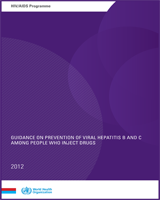It is recommended that this guidance be implemented in phases, consistent with the level of resources available. Consideration should be given to building awareness of this guidance among health-care workers and PWID. Specific issues regarding viral hepatitis among PWID that should be considered in the implementation of these guidelines in the local context include health systems, prevention services and community involvement.
9.1. Health systems
Health systems should work to increase awareness of viral hepatitis among health-care workers. The approach should include, but not be limited to, decreasing stigma towards most-at-risk populations and increasing the willingness of health-care workers to provide services to them. Efforts to decrease stigma involve addressing service providers' beliefs about and attitudes towards these populations. Also, health systems should build the capacity of health-care providers working with PWID to offer viral hepatitis and HIV prevention, testing, and diagnosis and treatment services.
9.2. Prevention services
Prevention services should promote health and treatment literacy about viral hepatitis transmission and prevention and should offer HBV vaccination for PWID. In addition, prevention services should advocate and implement a comprehensive package of harm reduction interventions.
9.3. Community involvement
PWID community groups should be involved in implementing the response to this guidance to ensure that it is meets community needs. It is important to consider the context in which injecting drug use occurs and in which services for PWID are delivered.

